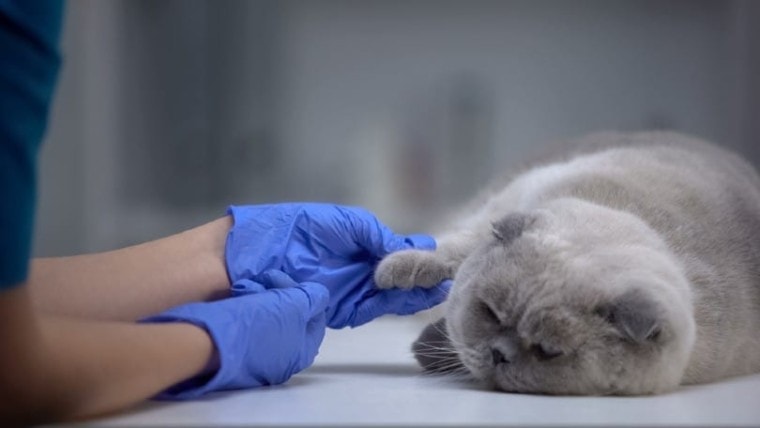
In most cases, you can’t catch diseases from your cat. However, there are a few diseases that can cross from humans to felines and vice versa. Diseases that can be transmitted between animals and humans are known as zoonotic diseases.
If you or your cat have one of these diseases, you may want to take precautions to avoid passing it back and forth.
Here is a list of diseases that can infect both cats and humans.
The 11 Diseases You Can Catch From Your Cat
1. Toxoplasmosis
Out of all the diseases that you can get from cats, toxoplasmosis is probably one of the most well-known. This parasite is harmless in most adults and children. However, it can cause birth defects in fetuses. For this reason, it is not recommended that pregnant people handle cat litter because it may be infected.
That said, most of the population likely has or has had toxoplasmosis. It is an extremely common parasite. Since most people are asymptomatic, they don’t even know they have it. (Birth defects are only caused when you are newly infected. Getting pregnant when you’re already infected typically doesn’t lead to birth defects.)
Not much is known about this parasite. We do know that it can cause brain changes in rats, and therefore, this may occur in people too. Specifically, it is thought to increase risk-taking behaviors.

2. Campylobacteriosis
This condition causes diarrhea and is typically not that serious. It is caused by the bacteria Campylobacter jejuni. Most of the transmission occurs from scooping out the litter box. However, keep in mind you could also get this from eating contaminated food or water. Infections are most common during the warmer months.
Outbreaks are rather rare, though. Most cases are single cases, not caused by outbreaks.
3. Ringworm
Despite the name, ringworm is actually not a parasite but a fungus that feeds on the keratin of the skin. Since it is so close to the surface of the skin, you can easily catch it by touching the infected part of your cat. Sometimes, cats develop areas of hair loss and characteristic circular red lesions or deeper “cigarette ash” lesions are visible. However, long-haired cats might not develop the sign of hair loss, so it can be hard to tell which parts are infected and which are not.
Therefore, it is relatively common for humans to contract ringworm from affected cats.

4. Cat Scratch Disease
This disease is caused by the bacterium Bartonella henselae, which often gets transferred to human skin through a cat scratch or when a feline licks a human’s open wound (which you should never allow your cat to do). It can also be transmitted when a cat bites you hard enough to break the skin, though this happens less often. Between cats, the bacteria is usually spread through infected flea bites.
Usually, this condition causes a blister accompanied by fever, headache, low appetite, and muscle and joint pain. The lymph nodes near the infection site can swell. Healthy adults will recover without lasting effects. Immunocompromised people and kids might need antibiotic therapy.
5. Roundworms and Hookworms
Intestinal parasites of the cat include hookworms and roundworms. In particular, Toxocara and Ancylostoma present a zoonotic risk from cats to humans. These parasites migrate through the skin and organs, causing swelling and damage. It is recommended to keep your cat’s deworming schedule up to date, along with getting annual fecal exams from the vet, using gloves to clean the litter box, and always washing your hands after cleaning the litter.
Keep an eye on children, as they are at higher risk of this disease because they bring their hands to their mouths more often.

6. Cryptosporidiosis
This parasite can infect most mammals, including cats and humans. Infection signs commonly include diarrhea, fever, and lack of appetite. You’re most likely to get it from scooping out the litter box.
It is always a good idea to wear gloves when scooping the litter box and to keep your cat’s antiparasitic schedules up to date.
7. Giardiasis
Giardia duodenalis is a parasite that can infect people and cats. Outside the body, this parasite can survive for weeks or even days, which makes it easier to spread around. You could get it from handling infected feces and directly from your cat. However, most cases of giardiasis in humans are caused by ingestion of contaminated food or water.
Usually, this condition leads to fever, itchy skin, and hives. However, it can also lead to weight loss over time. Some people don’t have any symptoms at all.

8. Salmonellosis
Out of all the conditions that you can catch from your cat, salmonellosis is one of the most common ones. This infection is caused by a bacterium called Salmonella. Cats on raw food diets are more prone to contracting a Salmonella infection. Transmission to humans is usually through contaminated food. Typically, this is considered a foodborne illness for this reason. Those infected will have a fever, diarrhea, and abdominal cramps within a couple of days. Recovery is often possible without medication after a few days of showing signs.
To avoid transmission, cook your cat’s food, wear gloves when you scoop the litter box, and wash your hands right after. Also, always wash your hands before eating or preparing food.
9. Rabies
Perhaps the most preventable disease that you could catch from your cat is rabies. Your feline should be vaccinated against this mortal viral disease. Rabies is transmitted through bodily fluids from infected animals. Typically, this occurs through bites.
Rabies is a disease that causes all sorts of strange signs. The virus attacks the nervous system and causes behavioral changes. Infected cats often become agitated and aggressive, which increases the chance of biting and the disease spreading. Humans often develop a fear of water, which leads to dehydration.

10. Sporotrichosis
Sporotrichosis is a fungal infection that occurs when people come into contact with a fungus called Sporothrix. If your cat is infected, you can also become infected after coming into contact with the fungal spores.
That said, this disease is rarely spread through animal contact. Instead, you’re most likely to become infected after contacting spores outside. This fungus can live in the soil and some plants.
11. Cat Tapeworm
Both cats and people can get tapeworms. Typically, you get this parasite after touching infected cat feces and then touching your mouth or face. There are several different species of tapeworm, but they are all quite similar.
It is extremely rare that humans get tapeworms from cats, but it is possible, so keeping your cat’s deworming schedule up to date is important.

Conclusion
There are several diseases that you can get from your cat. Fortunately, most of these conditions are benign and not linked to many serious complications. Those with compromised immune systems and children may be more prone to severe illness, though, so they may need to take more precautions.
Furthermore, actually catching any of these illnesses from your cat is typically quite rare. We have vaccinations for things like rabies, which cuts the odds down to practically zero as long as your cat has received their vaccines.
Many of these diseases are passed through feces. Therefore, you must use proper hygiene when handling the litter box.
You may also want to read:
Featured Image Credit: Motortion-Films, Shutterstock






